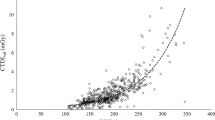Abstract
Background
Size-specific dose estimate is gaining increased acceptance as the preferred index of CT dose in children. However it was developed based on non-clinical data.
Objective
To compare the accuracy of size-specific dose estimate (SSDE) based on geometric and body weight measures in pediatric chest and abdomen CT scans, versus the more accurate \( \overline{\mathrm{SSDE}} \) (mean SSDE based on water-equivalent diameter).
Materials and methods
We retrospectively identified 50 consecutive children (age <18 years) who underwent chest CT examination and 50 children who underwent abdomen CT. We measured anteroposterior diameter (DAP) and lateral diameter (DLAT) at the central slice (of scan length) of each patient and calculated DAP+LAT (anteroposterior diameter plus lateral diameter) and DED (effective diameter) for each patient. We calculated the following in each child: (1) SSDEs based on DAP, DLAT, DAP+LAT, DED, and body weight, and (2) SSDE based on software calculation of mean water-equivalent diameter (\( \overline{\mathrm{SSDE}} \) adopted standard within our study). We used intraclass correlation coefficient (ICC) and Bland–Altman analysis to compare agreement between the SSDEs and \( \overline{\mathrm{SSDE}} \).
Results
Gender and age distribution were similar between chest and abdomen CT groups; mean body weight was 37 kg for both groups, with ranges of 6–130 kg (chest) and 8–107 kg (abdomen). SSDEs had very strong agreement (ICC>0.9) with \( \overline{\mathrm{SSDE}} \). SSDEs based on DLAT had 95% limits of agreement of up to 43% with \( \overline{\mathrm{SSDE}} \). SSDEs based on other parameters (body weight, DAP, DAP+LAT, DED) had 95% limits of agreement of up to 25%.
Conclusion
Differences between SSDEs calculated using various indications of patient size (geometric indices and patient weight) and the more accurate \( \overline{\mathrm{SSDE}} \) calculated using proprietary software were generally small, with the possible exception for lateral diameter, and provide acceptable dose estimates for body CT in children.


Similar content being viewed by others
References
Slovis TL (2002) The ALARA concept in pediatric CT: myth or reality? Radiology 223:5–6
Berdon WE, Slovis TL (2002) Where we are since ALARA and the series of articles on CT dose in children and risk of long-term cancers: what has changed? Pediatr Radiol 32:699
Brody AS, Frush DP, Huda W et al (2007) Radiation risk to children from computed tomography. Pediatrics 120:677–682
Huda W, Mettler FA (2011) Volume CT dose index and dose-length product displayed during CT: what good are they? Radiology 258:236–242
Boone JM, Strauss KJ, Cody DD et al (2015) Size-specific dose estimates (SSDE) in pediatric and adult body CT examinations. AAPM report No. 204. https://www.aapm.org/pubs/reports/RPT_204.pdf. Accessed 15 Feb 2016
McCollough CH, Leng S, Yu L et al (2011) CT dose index and patient dose: they are not the same thing. Radiology 259:311–316
Strauss KJ, Goske MJ (2011) Estimated pediatric radiation dose during CT. Pediatr Radiol 41:472–482
Leng S, Shiung M, Duan X et al (2015) Size-specific dose estimates for chest, abdominal, and pelvic CT: effect of intrapatient variability in water-equivalent diameter. Radiology 276:184–190
Christianson O, Li X, Frush D et al (2012) Automated size-specific CT dose monitoring program: assessing variability in CT dose. Med Phys 39:7131–7139
Brady SL, Mirro AE, Moore BM et al (2015) How to appropriately calculate effective dose for CT using either size-specific dose estimates or dose-length product. AJR Am J Roentgenol 204:953–958
Christner JA, Braun NN, Jacobsen MC et al (2012) Size-specific dose estimates for adult patients at CT of the torso. Radiology 265:841–847
McCollough C, Bakalyar DM, Bostani M et al (2015) Use of water equivalent diameter for calculating patient size and size-specific dose estimates (SSDE) in CT. AAPM Report No. 220. https://www.aapm.org/pubs/reports/RPT_220.pdf. Accessed 15 Feb 2016
Khawaja RD, Singh S, Vettiyil B et al (2015) Simplifying size-specific radiation dose estimates in pediatric CT. AJR Am J Roentgenol 204:167–176
Strauss KJ (2014) Dose indices: everybody wants a number. Pediatr Radiol 44:450–459
Pourjabbar S, Singh S, Padole A et al (2014) Size-specific dose estimates: localizer or transverse abdominal computed tomography images? World J Radiol 6:210–217
Wang J, Christner JA, Duan X et al (2012) Attenuation-based estimation of patient size for the purpose of size specific dose estimation in CT. Part II. Implementation on abdomen and thorax phantoms using cross sectional CT images and scanned projection radiograph images. Med Phys 39:6772–6678
Author information
Authors and Affiliations
Corresponding author
Ethics declarations
Conflicts of interest
None
Rights and permissions
About this article
Cite this article
Karmazyn, B., Ai, H., Klahr, P. et al. How accurate is size-specific dose estimate in pediatric body CT examinations?. Pediatr Radiol 46, 1234–1240 (2016). https://doi.org/10.1007/s00247-016-3604-0
Received:
Revised:
Accepted:
Published:
Issue Date:
DOI: https://doi.org/10.1007/s00247-016-3604-0




